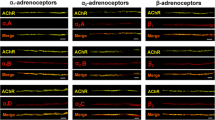Summary
A 6-hydroxydopamine analogue, 6-aminodopamine (6-ADA), was compared with 6-hydroxydopamine (6-OHDA) as a potential agent for chemical sympathectomy. The adrenergic terminals innervating arterioles of the frog retrolingual membrane were used as a test system. Four days after two topical treatments with 0.25 mg/ml of either drug, most of the periarteriolar adrenergic nerves demonstrated swelling, fiber disruption, or a bright beaded appearance in the fluorescence microscope. Treatment with 0.5 mg/ml 6-OHDA abolished all fluorescence. After 0.5 mg/ml 6-ADA, no normal adrenergic fibers were seen, although a few fibers survived and exhibited a beaded appearance. In contrast to 6-OHDA, this higher dose of 6-ADA produced some signs of general tissue toxicity. After treatment with either drug, electron microscopy revealed adrenergic nerves with large electron-opaque structures containing the degenerated remains of large granular vesicles. Nerve areas which contained the degenerating structures occasionally alternated with swollen axonal regions containing many microtubules but no vesicles. Cholinergic nerves showed no evidence of damage. These results suggest that 6-ADA selectively destroys peripheral adrenergic nerves much like 6-OHDA, providing an additional marker for the ultrastructural identification of adrenergic nerves. Their analogous chemical suggest a similar metabolic mechanism for destruction of adrenergic nerves.
Similar content being viewed by others
References
Azuma, T., Binia, A., Visscher, M. B.: Adrenergic mechanisms in the bullfrog and turtle. Amer. J. Physiol.209, 1287–1294 (1965)
Baumgarten, H. G., Björklund, A., Lachenmayer, L., Nobin, A., Stenevi, V.: Long-lasting selective depletion of brain serotonin by 5,6-dihydroxytryptamine. Acta physiol. scand., Suppl.373, (1971)
Berman, H. J., Siggins, G. R.: Neurogenic factors in the microvascular system. Fed. Proc.27, 1384–1390 (1968)
Blank, C. L., Kissinger, P. T., Adams, R. N.: 5,6-Dihydroxyindole formation from oxidized 6-hydroxydopamine. Europ. J. Pharmacol.19, 391–394 (1972a)
Blank, C. L., Murrill, E., Adams, R. N.: Central nervous system effects of 6-aminodopamine and 6-hydroxydopamine. Brain Res.45, 635–637 (1972b)
Bloom, F. E., Algeri, S., Groppetti, A., Revuelta, A., Costa, E.: Selective lesion of central norepinephrine terminals with 6-OH dopamine: combined biochemical and fine structural analysis. Science166, 1284–1286 (1969)
Falck, B., Häggendal, J., Owman, Ch.: The localization of adrenaline in adrenergic nerves in the frog. Quart. J. exp. Physiol.48, 253–257 (1963)
Falck, B., Hillarp, N. A., Thieme, G., Torp, A.: Fluorescence of catecholamines and related compounds condensed with formaldehyde. J. Histochem. Cytochem.10, 349–354 (1962)
Heikkila, R., Cohen, G.: Inhibition of biogenic amine uptake by hydrogen peroxide: a mechanism for toxic effects of 6-hydroxydopamine. Science172, 1257–1258 (1971)
Heikkila, R. E., Cohen, G.:In vivo generation of hydrogen peroxide from 6-hydroxydopamine. Experientia (Basel)28, 1197 (1972)
Heikkila, R. E., Mytilineou, C., Côté, L., Cohen, G.: Evidence for degeneration of sympathetic nerve terminals caused by the ortho-and para-quinones of 6-hydroxydopamine. J. Neurochem.20, 1345–1350 (1973)
Jonsson, G.: Quantitation of fluorescence of biogenic monoamines. Progr. Histochem. Cytochem.2, 299–334 (1971)
Malmfors, T., Sachs, C.: Degeneration of adrenergic nerves produced by 6-hydroxydopamine. Europ. J. Pharmacol.3, 89–92 (1968)
Powell, W. S., Heacock, R. S.: The oxidation of 6-hydroxydopamine. J. Pharm. Pharmacol.25, 193–200 (1973)
Sachs, C.: Failure of 6-hydroxynoradrenaline to produce degeneration of catecholamine neurons. Europ. J. Pharmacol.20, 149–155 (1972)
Saner, A., Thoenen, H. T.: Model experiments on the molecular mechanism of action of 6-hydroxydopamine. Molec. Pharmacol.7, 147–154 (1971)
Siggins, G. R.: Nervous control of the arterioles in the retrolingual membrane of the frog (Rana pipiens). Doctoral dissertation, Boston University Graduate School (1967)
Siggins, G. R., Bloom, F. E.: Cytochemical and physiological effects of 6-hydroxydopamine on periarteriolar nerves of frogs. Circulat. Res.27, 23–38 (1970)
Siggins, G. R., Forman, D. S., Bloom, F. E., Sims K. L., Adams, R. N.: Destruction of peripheral and central adrenergic nerves by 6-aminodopamine (6-ADA). Fed. Proc.32, 692 (1973)
Siggins, G. R., Weitsen, H. A.: Cytochemical and physiological evidence for cholinergic, neurogenic vasodilation of amphibian arterioles and pre-capillary sphincters. I. Light microscopy. Microvascular Res.3, 308–322 (1971)
Stone, C. A.: Hypotensive 4,5-dihydroxy-a-methyl-phenylethylamine derivatives. Chem. Abstr.61 6953 e. Belgian Patent No. 633, 963 (1964)
Thoenen, H. Tranzer, J.-P. Chemical sympathectomy by selective destruction of adrenergic nerve endings with 6-hydroxydopamine. Naunyn-Schmiedebergs. Arch. Pharmak. exp. Path.261, 271–288 (1968)
Tranzer, J.-P., Thoenen, H.: An electron microscopic study of selective, acute degeneration of sympathetic nerve terminals after administration of 6-hydroxydopamine. Experientia (Basel)24, 155–156 (1968)
Tranzer, J.-P., Thoenen, H.: Selective destruction of adrenergic nerve terminals by chemical analogues of 6-hydroxydopamine. Experientia (Basel)29, 314–315 (1973)
Wagner, K.: Uncoupling of oxidative phosphorylation by 6-hydroxydopamine. In: 6-Hydroxydopamine and catecholamine neurons (T. Malmfors and H. Thoenen, eds.), p. 277–278. Amsterdam: North-Holland Publishing Co. 1971
Wherli, P. A., Piggot, F., Fischer, U., Kaiser, A.: Oxydationsprodukte von 6-Hydroxydopamin. Helv. chim. Acta55, 3057–3061 (1972)
Author information
Authors and Affiliations
Additional information
We are indebted to C. L. Blank and R. N. Adams for samples of the 6-ADA and valuable discussions during the course of this work. We thank Elena Battenberg and Larry Ballentine for technical assistance, and F. E. Bloom and K. L. Sims for critical evaluation of the manuscript.
Rights and permissions
About this article
Cite this article
Siggins, G.R., Forman, D.S. Degenerative effects of 6-aminodopamine and 6-hydroxydopamine on peripheral adrenergic nerves. Z.Zellforsch 146, 339–349 (1973). https://doi.org/10.1007/BF02346226
Received:
Issue Date:
DOI: https://doi.org/10.1007/BF02346226




